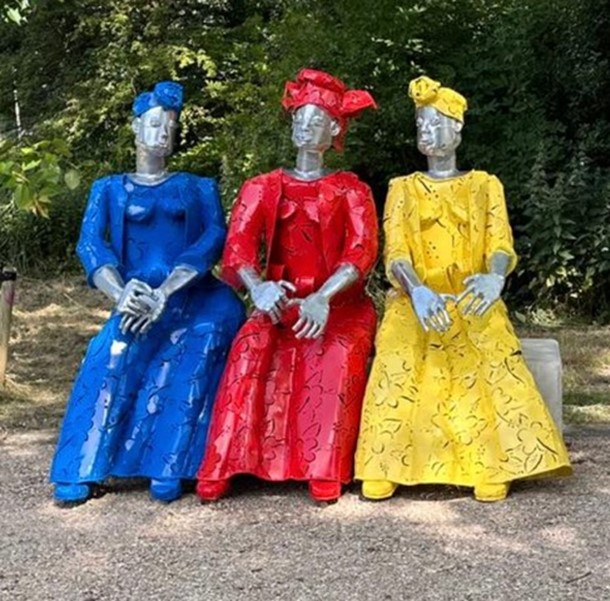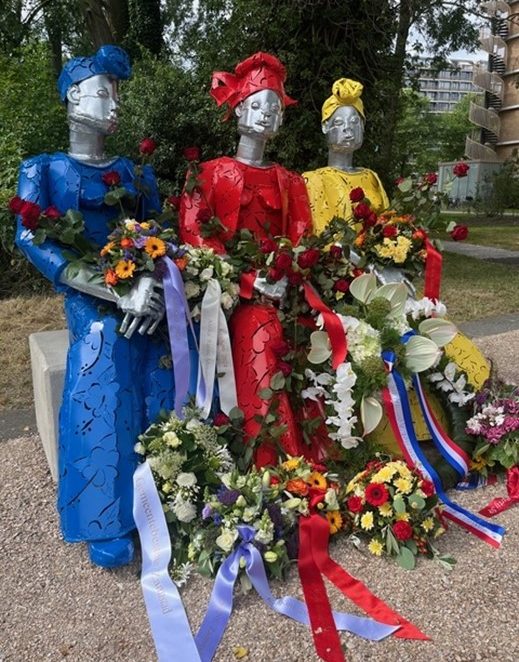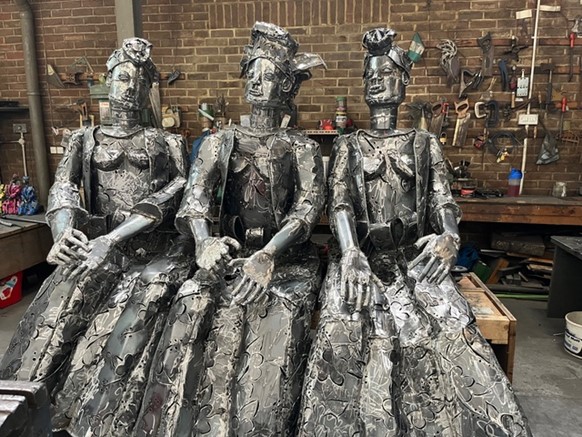A tribute to Keti Koti
Sokari Douglas Camp’s ‘The Three Graces – The Dialogue’: galvanized and powder coated by Joseph Ash Medway


On Sunday 30th June, in the Kleurenbuurt neighbourhood of Zaandam, Netherlands, a powerful sculpture by artist Sokari Douglas Camp, was unveiled. Named The Three Graces – The Dialogue, the artwork was created in commemoration of Keti Koti.
Keti Koti, meaning “broken chains,” is an annual event held across the Netherlands to mark Emancipation Day in Surinam, a former Dutch colony. The celebration, held on 1st July, commemorates the abolition of slavery in 1863 and serves as a moment to honour those who lived in bondage while reflecting on the significance of living in freedom. In this context, The Three Graces takes its place as a focal point for healing the wounds of the past and encouraging dialogue about a shared and often painful history.
The sculpture and its meaning

Sokari Douglas Camp, renowned for her artistic work with steel, designed The Three Graces – The Dialogue as a symbol of resilience, healing, and unity. The sculpture draws direct inspiration from an 18th-century piece by abolitionist William Blake titled Europe Supported by Africa and America. (A print of this can be seen in the library at the Victoria and Albert Museum.) Blake’s piece depicts three women – an African woman and American Indian woman shown unclothed, and a European woman, partially clothed. The difference in clothing signifies the imbalanced power dynamics of that era. Sokari, however, sought to reclaim and reframe this narrative.
In her vision, the three figures are African women, fully clothed, sitting as equals. Their elaborate and voluminous skirts, a nod to the fashion of Surinamese women, are rich with cultural meaning. Surinamese women, known for wearing multiple layers of clothing at once, developed this style partly due to the lack of storage space but also as a protective measure against the risk of assault.
The Three Graces – The Dialogue shows the women engaged in an imagined conversation about their shared history of slavery and the continuing struggle for reparations and justice. This dialogue is a visual and symbolic centrepiece for Keti Koti’s annual remembrance and reflection.
Craftsmanship and preservation
The sculpture was welded from 3ml sheet steel, blending the industrial toughness of metal with the fluidity and grace of human forms. Joseph Ash Galvanizing was commissioned to galvanize and powder coat the work to ensure its durability and protect it from the elements. The galvanizing process involved coating the steel with a layer of zinc, providing a robust and reliable defence against corrosion. This ensures that the statue, much like the history it represents, will endure for generations.
The unveiling and community reception
The unveiling ceremony in Kleurenbuurt attracted around 200 people, including Sokari Douglas Camp herself. The community gathered in a spirit of remembrance, reflection, and celebration, marking The Three Graces as a focal point of collective healing.
In the tradition of Keti Koti, the piece serves as a catalyst for conversation – an essential dialogue about history, memory, and the need for reparations.
A lasting legacy
Sokari Douglas Camp’s The Three Graces – The Dialogue stands as a testament to the enduring impact of slavery, the strength of those who survived, and the continued efforts toward healing and reconciliation. Its ongoing and permanent presence in Zaandam’s Kleurenbuurt ensures that the story of Keti Koti and the voices it represents will continue to resonate with all who see it.

This piece, galvanized and protected, will remain a lasting symbol of the power of art to inspire reflection, conversation, and healing.
To see more of Sokari Douglas Camp’s work, visit her website.
You can also visit galleries such as the V&A, The Smithsonian Institute and The October Gallery where she has permanent pieces of art on display.
To see more of Sokari’s work galvanized by Joseph Ash, read Celebrating the Heritage of Carnival and Jonkonnu.
Special mentions
When Sokari fabricated The Three Graces – The Dialogue she had help in her studio from her assistant, who deserves a mention. His name is Luke Chin-Joseph.
A company called MDM Props also deserves a mention as they transported the finished sculpture from Joseph Ash Medway to The Netherlands. MDM Props deals in art manufacture, scenic construction, and prop making, and regularly works with both Sokari Douglas Camp and Joseph Ash Galvanizing.
Finally, a special mention goes to the municipality of Zaandam who made this commission possible.
Next page